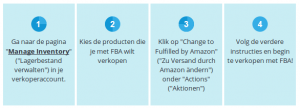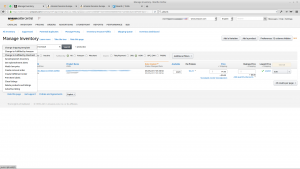FBA (Amazon)
FBA staat voor Fulfilment by Amazon. Het houdt in dat Amazon het voorraadbeheer van je goederen doet in hun magazijn(en). Het is de tegenpool van FBM - Fulfillment by Merchant.
Voordelen
- Prime: Je kunt alleen Amazon Prime-klanten bedienen als je gebruikt maakt van FBA. Prime wil zeggen, dat goederen binnen twee dagen bezorgd worden
- Levering: Ook los van Prime, is er weinig kans dat je zelf zo snel kunt leveren als Amazon dat kan via FBA
- Soepelere performance-indicatoren: Op het moment dat Amazon de voorraad regelt, komen de performance-indicatoren die daar betrekking op hebben, te vervallen. Da's handig
- Minder risico: Niet alleen je performance-indicatoren worden soepeler, maar ook andere risico's (zoals voor beschadigde goederen) worden nu gedragen door Amazon
- Minder werk: Uiteraard scheelt het een hoop werk, als je niet meer zelf voor verzending hoeft te zorgen. Het schaalt ook beter
- Schaling: Met FBA schaalt je business gemakkelijker, omdat het extra werk door Amazon verricht wordt
- Concurrentiepositie: Je hebt dankzij Prima en snellere levering een flink voordeel op concurrenten.
Nadelen
- Controle: Verlies van controle over je eigen producten. En da's nogal significant, omdat het heel vervelend kan zijn om zaken te doen met Amazon op het moment dat dingen niet lekker lopen
- Kapitaalkosten: In veel gevallen zal je voorraad versnipperd raken over twee locaties: Je eigen magazijn en dat van Amazon. Daarnaast is er een kans dat FBA via verschillende Amazon-magazijnen verloopt, wat dus extra kapitaalkosten met zich meeneemt.
Overige factoren
- Verzendproblemen: Hoe vaak raken FBM-zendingen beschadigd of verloren? Dat is een voordeel van FBA
- Rotatiesnelheid: FBA is vooral interessant voor fast movers, maar kan zelfs per saldo een kostenpost worden voor slow movers.
Details
- Je hoeft niet in één keer met al je producten over te stappen. Je bepaalt zelf welke producten je via FBA wilt laten verlopen
Evaluaties
Enkele reacties uit deze forum-thread. FBM staat trouwens voor Fulfilment By Merchant:
I do NOT. I find the the increase in sales does not justify the increased fees involved with FBA. (pick and pack, storage fees, shipping costs to deliver to Amazon, Labor and material costs to prep items to send to Amazon, etc...) The final deciding factor for me after using FBA for 2 years was the amount of time I had to spend following up on all the refunds due to me that were not processed properly. I tried it for 2 years myself and went 100% FBM 1 year ago and after this amount of time and going through the numbers I have a much larger profit margin be doing 100% FBM. (of course I also had a significant drop in the number of sales but my overall bottom line is now greater) I am sure that for many people FBA may be the best option and also for many it may be the only option. This is a business decision that you need to make on your own.
We do both FBA and FBM. Item pricing, shipping, storage, demand, competition, etc. all play a part in determining what channel is best for our bottom line. Currently we are about 80% FBA and 20% FBM. More popular, fast selling items we prefer FBA since storage fees are minimal and we can have many orders without having to do the shipping ourselves. For slower selling, bulkier items, we prefer to fulfill ourselves. The only exception to this rule is for high valued products where we will have Amazon take on any non-delivery or damaged claims themselves. It is a balancing act to maximize sales while minimizing costs. Although we can usually charge more through FBA, if the items do not sell, that extra income is absorbed by storage fees.
Hoe het werkt
Let op: Als je een product hebt omgezet van FBM naar FBA, is het product niet verkrijgbaar totdat het is gearriveerd in het Amazon-warenhuis.
Label preferences
- Je moet twee keuzes maken. Alle varianten (ja/ja, ja/nee, nee/ja, nee/nee) zijn mogelijk
- Alle producteenheden moeten een scanbare barcode hebben
- Producteenheden met een bestaande barcode komen mogelijk in aanmerking voor Stickerless, Commingled Inventory of in aanmerking voor FBA Label Service
Stickerless, Commingled Inventory = Products with original barcode
Dit betekent dat de barcodes die op de producten staan, ok zijn [1]. Specifieker:
- Dit geldt alleen voor EAN-codes, niet voor ISBN, UPC of JAN
- De barcodes zijn gedrukt op de producteenheidverpakking
- Producteenheden hebben één barcode
- De barcodes zijn dezelfde als bekend bij Amazon voor deze producten
- Er is een 1-op-1-correspondentie tussen barcode en Amazon ASIN
- Dit betreft een product in nieuwstaat: Producten worden eventueel gehomogeniseerd met dezelfde producten van andere leverancies (commingled)
- Geen producten met een uiterste houdbaarheidsdatum
- Dit zijn geen consumeerbare producten of tropische producten zoals huidcrèmes, shampoo of cosmetica.
FBA Product Labels
- Aka FBA Item Labels
- Dit is de situatie waarin de barcodes die op de producten staan, niet ok zijn
- Zorg ervoor dat de oorspronkelijke barcode niet meer zichtbaar is.
FBA Label Service
- Indien je gebruik moet maken van FBA product labels, kun je kiezen om de labels zelf op te plakken, of om dit door Amazon te laten doen
- Door Amazon laten doen? Daar zijn kosten aan verbonden.
FBA Product Labels - Zelf doen
- Labels zijn minimaal 25.4mm x 50.8mm
- Details [2]:
Use an Amazon barcode to track inventory Products that do not use the manufacturer barcode for tracking require an Amazon barcode. You can print Amazon barcodes from within your seller account and apply the barcodes yourself. If you do not want to apply the barcodes yourself, you can also sign up for the FBA Label Service and have Amazon apply the labels for you for a per-item fee. For more information, see FBA Label Service. For eligible products, you can use the manufacturer barcode to track your inventory. For more information, see Use the manufacturer barcode to track inventory. Any item that requires an Amazon barcode that arrives at a fulfillment center without one will be subject to an unplanned service fee. For more information, see Unplanned Prep Services. Print Amazon barcodes You can print Amazon barcodes for your products from the Label Products page when you create a shipment, or at any time from the Manage Inventory page. If you use a thermal printer, labels are printed immediately. For laser printers, a PDF is generated that you can use to print labels using standard label paper. To print Amazon barcodes from the Label Products page: 1. Select the shipment that you want to work on from the Shipping Queue page. 2. In the Items column, verify the number of each product that you want to send. 3. At the bottom of the page, click Print labels. For thermal printers, the labels will print automatically. For laser printers, a PDF will be generated for use with label paper. To print Amazon barcodes from the Manage Inventory page: 1. Select the products in the left column. 2. Selecting Print Item Labels from the Action on Selected Item(s) drop-down menu. Amazon barcode requirements Amazon barcodes must remain scannable for a minimum of 24 months. Following the printer and label requirements will help ensure the longevity of your Amazon barcode. When printing Amazon barcodes onto labels, make sure that the printed labels include: * Sufficient white space around the Amazon barcode and related text (6.4mm on the sides and 3.2mm on the top and bottom) * ASIN or SKU * Product name * Item condition Label placement requirements All barcodes on the package must be covered, including the manufacturer barcode. Failure to do so can cause delays in processing and may result in unplanned prep service fees. * Put the correct barcode on each item * Cover all other visible barcodes * Place the barcode on the outside of any prep materials * Do not place the barcode on a curve or corner of the package * Allow 6.4mm between the edge of the label and the edge of the packaging * Ensure each item in a case pack has an Amazon barcode, and any barcodes on the case have been removed Printer requirements * The tools in your seller account are optimized for thermal printers. You can also use laser printers. Do not use ink jet printers to print Amazon barcodes. * Tip: Amazon fulfillment centers currently use Zebra GX430t model printers with a direct thermal setting. We also recommend that you: * Periodically test your Amazon barcodes by scanning them * Use a printer with a print resolution of 300 DPI or greater * Periodically test, clean, and replace your printer heads Label paper requirements * All Amazon barcodes must be printed in black ink on white, non-reflective labels with removable adhesive. Dimensions must be between 25.4mm x 50.8mm and 50.8mm x 76.2mm (25.4mm x 76.2mm or 50.8mm x 50.8mm, for example). For laser printers, the tools in your seller account support the following label sizes: * 21 labels per page (63.5 mm x 38.1 mm on A4) * 24 labels per page (63.5 mm x 33.9 mm on A4, 63.5 mm x 38.1 mm on A4, 64.6 mm x 33.8 mm on A4, 66.0 mm x 33.9 mm on A4, 70.0 mm x 36.0 mm on A4, 70.0 mm x 37.0 mm on A4) * 27 labels per page (63.5 mm x 29.6 mm on A4) * 30 labels per page (1" x 2 5/8" on US Letter) * 40 labels per page (52.5 mm x 29.7 mm on A4) * 44 labels per page (48.5 mm x 25.4 mm on A4) If your printer attempts to scale the PDF print area when you print your labels, make sure that the printer scaling is set to None or 100%.
Bronnen
- https://sellercentral.amazon.com/forums/thread.jspa?messageID=4092155� Do most of you prefer FBA over shipping your own stock?
- https://www.entrepreneur.com/article/282277 - Guide to Starting a Fulfillment by Amazon Business
- https://www.entrepreneur.com/article/280495 - The Pros and Cons of Buying a 'Fulfillment by Amazon' Business
- https://www.entrepreneur.com/article/271213 - 5 Ways To Grow Your 'Fulfillment by Amazon' Business
- https://sampriestley.com/amazon-fba-business/
Aan de slag
- https://services.amazon.de/programme/versand-durch-amazon/online-verkopen-promotie-fba.htm
- https://sellercentral.amazon.de/gp/help/200141480#qualifications - Stickerless, Commingled Inventory
- https://sellercentral.amazon.de/gp/help/help-popup.html/ref=ag_200141490_cont_fbainventy?ie=UTF8&itemID=200141490# - Use an Amazon barcode to track inventory → Alle details omtrent afdrukken & opplakken
- https://services.amazon.de/programme/versand-durch-amazon/online-verkopen-promotie-fba.htm



